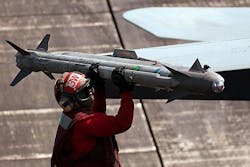Navy makes 317-missile order of AIM-9X infrared-guided air-to-air weapon for Navy and Air Force
PATUXENT RIVER NAS, Md. – U.S. Navy air warfare experts are asking missile experts at the Raytheon Co. to build 317 AIM-9X precision short-range infrared-guided air-to-air missiles for jet fighters and other combat aircraft under terms of a $199.8 million order announced Friday.
Officials of the Naval Air Systems Command at Patuxent River Naval Air Station, Md., are asking the Raytheon Missile Systems segment in Tucson, Ariz., to build lot 17 of the AIM-9X block II air-to-air missiles for the U.S. Navy, and Air Force.
The contract also calls for Raytheon to build 199 Block II captive air training missiles -- 24 for the Navy, 77 for the, 48 for Australia, 20 for Indonesia, 20 for the Netherlands, six for Romania, and four for Poland. The order also involves a variety of other AIM-9X missile equipment for the U.S. and foreign militaries.
The AIM-9X is a relatively short-range infrared heat-seeking missile that equips most jet fighters, fighter-bombers, and other offensive combat aircraft in the U.S. arsenal, and is for shooting down enemy aircraft close by. The AIM-9X works by homing in on an enemy aircraft's hot engine exhaust. Variants of the AIM-9 Sidewinder have been deployed since the 1950s.
The AIM-9X is among the latest versions of the AIM-9 missile family. It entered service in 2003 on the Navy F/A-18C Hornet fighter-bomber and on the U.S. Air Force F-15C jet fighter. It has an imaging infrared focal plane array seeker with 90-degree off-boresight capability for accuracy.
The missile is compatible helmet-mounted displays such as the U.S. Joint Helmet Mounted Cueing System, and features 3-D thrust-vectoring control for increased turn capability. The AIM-9X also includes an internal cooling system.
Friday's contract involves the latest version of the AIM-9X, called the AIM-9X Block II. This newest version has lock-on after launch capability for use with the F-35 Lightning II joint strike fighter and the F-22 Raptor advanced tactical fighter.
story continues below
The contract also includes 10 special air training missiles for Australia and five for Taiwan; 43 all up round containers for the Navy, 81 for the Air Force (81), 15 for Australia, 10 for the Netherlands, six for Indonesia, two for Romania, two for Taiwan, and one for Poland; one spare advanced optical target detector for the Navy, two for the Air Force, two for Australia, one for Indonesia, and one for Poland; two spare live battery guidance units for the Navy, four for the Air Force, three for Romania, and two for Indonesia; two spare captive air training missile guidance units for the Navy, six for the Air Force, 10 for Australia, two for Indonesia, and two for Romania; 10 guidance unit containers for the Air Force, six for Australia, five for Romania, and two for Indonesia; two spare advanced optical target detector containers for Australia, one for Indonesia, and one for Poland; one spare block 1 propulsion steering section and one spare block II propulsion steering section for the Air Force; and AIM-9X missile spare parts Navy, Air Force, Australia, Turkey, Denmark, Finland, Israel, Belgium, Netherlands, Singapore, Poland, Switzerland, Japan, Norway, Morocco, Romania, Korea, Saudi Arabia, Taiwan.
On this contract modification Raytheon will do the work in Tucson, Ariz.; Andover, Mass.; Valencia, Goleta, Chatsworth, San Diego, Newbury Park, El Segundo, Claremont, El Cajon, and San Jose, Calif.; Midland and Rocket Center, W.Va.; Ontario, Canada; Vancouver, Wash; Cheshire and Simsbury, Conn.; Heilbronn, Germany; Anniston, Ala.; Maniago, Italy; Orlando, Fla.; Joplin, Mo.; Lombard, Ill.; and in other locations inside and outside the U.S., and should be finished by March 2020.
For more information contact Raytheon Missile Systems online at paste link here www.raytheon.com, or Naval Air Systems Command at www.navair.navy.mil.
Learn more: search the Aerospace & Defense Buyer's Guide for companies, new products, press releases, and videos

